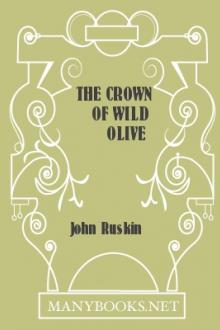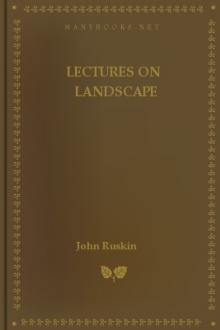The Crown of Wild Olive by John Ruskin (a court of thorns and roses ebook free .TXT) 📕

- Author: John Ruskin
- Performer: -
Book online «The Crown of Wild Olive by John Ruskin (a court of thorns and roses ebook free .TXT) 📕». Author John Ruskin
108. Yes, we say, and know, that these things are true; and true for ever: battles of the gods, not among themselves, but against the earth-giants. Battle prevailing age by age, in nobler life and lovelier imagery; creation, which no theory of mechanism, no definition of force, can explain, the adoption and completing of individual form by individual animation, breathed out of the lips of the Father of Spirits. And to recognize the presence in every knitted shape of dust, by which it lives and moves and has its being—to recognize it, revere, and show it forth, is to be our eternal Idolatry.
"Thou shalt not bow down to them, nor worship them."
"Assuredly no," we answered once, in our pride; and through porch and aisle, broke down the carved work thereof, with axes and hammers.
Who would have thought the day so near when we should bow down to worship, not the creatures, but their atoms,—not the forces that form, but those that dissolve them? Trust me, gentlemen, the command which is stringent against adoration of brutality, is stringent no less against adoration of chaos, nor is faith in an image fallen from heaven to be reformed by a faith only in the phenomenon of decadence. We have ceased from the making of monsters to be appeased by sacrifice;—it is well,—if indeed we have also ceased from making them in our thoughts. We have learned to distrust the adorning of fair phantasms, to which we once sought for succour;—it is well, if we learn to distrust also the adorning of those to which we seek, for temptation; but the verity of gains like these can only be known by our confession of the divine seal of strength and beauty upon the tempered frame, and honour in the fervent heart, by which, increasing visibly, may yet be manifested to us the holy presence, and the approving love, of the Loving God, who visits the iniquities of the Fathers upon the Children, unto the third and fourth generation of them that hate Him, and shows mercy unto thousands in them that love Him, and keep His Commandments.
[118] I shall be obliged in future lectures, as hitherto in my other writings, to use the terms, Idolatry and Imagination in a more comprehensive sense; but here I use them for convenience sake, limitedly, to avoid the continual occurrence of the terms, noble and ignoble, or false and true, with reference to modes of conception.
[119] "And in sum, he himself (Prometheus) was the master-maker, and Athena worked together with him, breathing into the clay, and caused the moulded things to have soul (psyche) in them."—Lucian, Prometheus.
[120] His relations with the two great Titans, Themis and Mnemosyne, belong to another group of myths. The father of Athena is the lower and nearer physical Zeus, from whom Metis, the mother of Athena, long withdraws and disguises herself.
[121] The Latin verses are of later date; the contemporary plain prose retains the Venetian gutturals and aspirates.
[122] The best modern illustrated scientific works show perfect faculty of representing monkeys, lizards, and insects; absolute incapability of representing either a man, a horse, or a lion.
LECTURE IV. LIKENESS. November, 1870.109. You were probably vexed, and tired, towards the close of my last lecture, by the time it took us to arrive at the apparently simple conclusion, that sculpture must only represent organic form, and the strength of life in its contest with matter. But it is no small thing to have that "λευσσω Παλλαδα" fixed in your minds, as the one necessary sign by which you are to recognize right sculpture, and believe me you will find it the best of all things, if you can take for yourselves the saying from the lips of the Athenian maids, in its entirety, and say also—λευσσω Παλλαδ' εμαν θεον. I proceed to-day into the practical appliance of this apparently speculative, but in reality imperative, law.
110. You observe, I have hitherto spoken of the power of Athena, as over painting no less than sculpture. But her rule over both arts is only so far as they are zoographic;—representative, that is to say, of animal life, or of such order and discipline among other elements, as may invigorate and purify it. Now there is a speciality of the art of painting beyond this, namely, the representation of phenomena of colour and shadow, as such, without question of the nature of the things that receive them. I am now accordingly obliged to speak of sculpture and painting as distinct arts, but the laws which bind sculpture, bind no less the painting of the higher schools which has, for its main purpose, the showing beauty in human or animal form; and which is therefore placed by the Greeks equally under the rule of Athena, as the Spirit, first, of Life, and then of Wisdom in conduct.
111. First, I say, you are to "see Pallas" in all such work, as the Queen of Life; and the practical law which follows from this, is one of enormous range and importance, namely, that nothing must be represented by sculpture, external to any living form, which does not help to enforce or illustrate the conception of life. Both dress and armour may be made to do this, by great sculptors, and are continually so used by the greatest. One of the essential distinctions between the Athenian and Florentine schools is dependent on their treatment of drapery in this respect; an Athenian always sets it to exhibit the action of the body, by flowing with it, or over it, or from it, so as to illustrate both its form and gesture; a Florentine, on the contrary, always uses his drapery to conceal or disguise the forms of the body, and exhibit mental emotion: but both use it to enhance the life, either of the body or soul; Donatello and Michael Angelo, no less than the sculptors of Gothic chivalry, ennoble armour in the same way; but base sculptors carve drapery and armour for the sake of their folds and picturesqueness only, and forget the body beneath. The rule is so stern that all delight in mere incidental beauty, which painting often triumphs in, is wholly forbidden to sculpture;—for instance, in painting the branch of a tree, you may rightly represent and enjoy the lichens and moss on it, but a sculptor must not touch one of them: they are inessential to the tree's life,—he must give the flow and bending of the branch only, else he does not enough "see Pallas" in it.
Or to take a higher instance, here is an exquisite little painted poem, by Edward Frere; a cottage interior, one of the thousands which within the last two months[123] have been laid desolate in unhappy France. Every accessory in the painting is of value—the fireside, the tiled floor, the vegetables lying upon it, and the basket hanging from the roof. But not one of these accessories would have been admissible in sculpture. You must carve nothing but what has life. "Why"? you probably feel instantly inclined to ask me.—You see the principle we have got, instead of being blunt or useless, is such an edged tool that you are startled the moment I apply it. "Must we refuse every pleasant accessory and picturesque detail, and petrify nothing but living creatures"?—Even so: I would not assert it on my own authority. It is the Greeks who say it, but whatever they say of sculpture, be assured, is true.
112. That then is the first law—you must see Pallas as the Lady of Life—the second is, you must see her as the Lady of Wisdom; or σοφια—and this is the chief matter of all. I cannot but think, that after the considerations into which we have now entered, you will find more interest than hitherto in comparing the statements of Aristotle, in the Ethics, with those of Plato in the Polity, which are authoritative as Greek definitions of goodness in art, and which you may safely hold authoritative as constant definitions of it. You remember, doubtless, that the σοφια or αρετη τεχνης, for the sake of which Phidias is called σοφος as a sculptor, and Polyclitus as an image-maker, Eth. 6. 7. (the opposition is both between ideal and portrait sculpture, and between working in stone and bronze) consists in the "νους των τιμιωτατων τη φυσει" "the mental apprehension of the things that are most honourable in their nature." Therefore what is, indeed, most lovely, the true image-maker will most love; and what is most hateful, he will most hate, and in all things discern the best and strongest part of them, and represent that essentially, or, if the opposite of that, then with manifest detestation and horror. That is his art wisdom; the knowledge of good and evil, and the love of good, so that you may discern, even in his representation of the vilest thing, his acknowledgment of what redemption is possible for it, or latent power exists in it; and, contrariwise, his sense of its present misery. But for the most part, he will idolize, and force us also to idolize, whatever is living, and virtuous, and victoriously right; opposing to it in some definite mode the image of the conquered ἑρπετον.
113. This is generally true of both the great arts; but in severity and precision, true of sculpture. To return to our illustration: this poor little girl was more interesting to Edward Frere, he being a painter, because she was poorly dressed, and wore these clumsy shoes, and old red cap, and patched gown. May we sculpture her so? No. We may sculpture her naked, if we like; but not in rags.
But if we may not put her into marble in rags, may we give her a pretty frock with ribands and flounces to it, and put her into marble in that? No. We may put her simplest peasant's dress, so it be perfect and orderly, into marble; anything finer than that would be more dishonourable in the eyes of Athena than rags. If she were a French princess, you might carve her embroidered robe and diadem; if she were Joan of Arc you might carve her armour—for then these also would be "των τιμιωτατων," not otherwise.
114. Is not this an edge-tool we have got hold of, unawares? and a subtle one too; so delicate and scimitar-like in decision. For note, that even Joan of Arc's armour must be only sculptured, if she has it on; it is not the honourableness or beauty of it that are enough, but the direct bearing of it by her body. You might be deeply, even pathetically, interested by looking at a good knight's dinted coat of mail, left in his desolate hall. May you sculpture it where it hangs? No; the helmet for his pillow, if you will—no more.
You see





Comments (0)